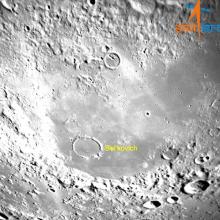Listen to today's episode of StarDate on the web the same day it airs in high-quality streaming audio without any extra ads or announcements. Choose a $8 one-month pass, or listen every day for a year for just $30.
You are here
Moon and Companions
Robert Peary and Richard Byrd both claimed they reached the north pole — Byrd by air, and Peary by dogsled. Today, both claims are disputed, although there’s no doubt that both men came close. And they’re just as close to the north pole of the Moon — each has a crater there named in his honor.
In fact, the names of several features at high northern latitudes are related to the Arctic. The most prominent is the Sea of Cold. This dark volcanic plain covers an area as big as the Black Sea here on Earth. It’s far enough from the pole that it’s visible to the unaided eye, near the “top” of the lunar disk.
The craters named for Peary and Byrd are much closer to the pole, and they’re not all that big, so they’re impossible to see without a telescope. Peary said that he reached Earth’s north pole in 1909. And Byrd claimed to have flown over the pole in 1926.
Another far-northern crater is named for Fridtjof Nansen, a Norwegian explorer. In 1895, he pushed farther north than anyone had gone before. And today, his feat is honored on the northern limb of the Moon.
And the Moon is in beautiful view tonight. It’s just past first quarter, so sunlight illuminates more than half of its disk. The Sea of Cold forms a narrow dark streak near the top of the disk. And the Moon is joined by two bright companions. The planet Saturn is close to the lower left of the Moon at nightfall, with the star Antares farther to the lower right of the Moon.
Script by Damond Benningfield





